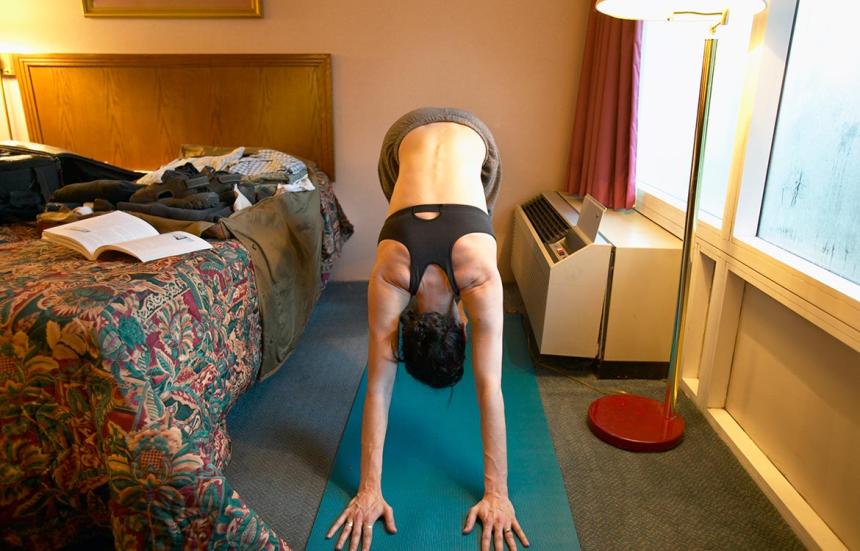4 Tips on How to Exercise While Traveling

Whether you are on vacation or a business trip, you can still get your workout into your day to stay in shape. You may have to adjust your usual routine, but you’ll find many options available to get a good workout while traveling.
Here are some useful tips to how to stay in shape:
- Plan Ahead
- Pack What You Need
- Schedule your activity into your agenda
- Get plenty of rest
There is a common misconception that it’s hard to maintain a healthy lifestyle while traveling. However, it’s actually a lot easier to stay active than most people think.
1. Plan ahead.
- If you’re staying at a hotel, visit the website ahead of time to check out their amenities. Many hotels have a swimming pool, fitness center, onsite trainers and/or group exercise classes.
- Are there any walking tours in the area? Walking tours are a safe way to see the city you are visiting, while moving and burning some calories.
- Find exercise videos that you could do in a hotel or guest room. Good examples include yoga and resistance bands/tubing workouts. Check out the Perfect Fit workouts on the MDVIP member portal.
2. Pack what you need.
Once you have planned ahead, you need to pack appropriately to give yourself the best chance at a successful travel workout. Bring your favorite apparel and tools to help with your exercise plans. These items often include:
- Sneakers
- Workout clothes
- Sunscreen
- Swimsuit (if you’re a swimmer and have access to a pool)
- Resistance bands and/or tubing
- Headphones
- Yoga mat (if it will fit into your luggage)
- Mobile device to download workouts
3. Schedule your activity in your agenda.
- If you’re traveling for business, schedule time before or after meetings to get your workout.
- Going to a conference? Most professional meetings schedule downtime for networking and sightseeing. Use some of this time to exercise.
- If you’re visiting family or friends, early mornings would probably work best. And you can invite your relatives and friends to join you.
4. Get plenty of rest.
- Traveling can be tiring, especially if you’re traveling to a different time zone. Your priority should be adequate rest over a workout. Exhaustion can suppress your immune system.
- Your body also may need a break from carrying luggage and other items. A few tips to prevent travel-related body aches include using rolling luggage, packing as light as possible and limiting your caffeine intake as it’s dehydrating, which can cause aches and pains.
You Need This Much Exercise to Stay in Shape
The American College of Sports Medicine and Centers for Disease Control and Prevention recommend healthy adults get a minimum of 30 minutes of moderate intensity aerobic activity five days per week or 20 minutes of vigorous activity three days per week.
This may be hard when you're on the road, but aerobic exercise helps keep the heart, lungs and circulatory system strong. Examples of moderate intensity aerobic activity include walking briskly or riding an exercise bike. Intense versions of these activities include running or cycling up and down hills.
If you’re trying to save time, look for activities that are weight bearing that require you to work against gravity like walking, running, hiking and pretty much any type of strength training. Weight bearing activities help keep your bones strong.
Since we lose muscle strength and endurances we age, it’s important to strength train twice a week, according to ACSM and the CDC. The obvious choice in strength training is lifting free weights or using weight machines, found in most hotels. But there are a lot more options such as Pilates, sculpting moves that use resistance bands and tubing and body weight exercises (push-ups, crunches, pull-ups, squats and lunges).
And make sure you’re stretching. Stretching helps ease aches and pains from sitting all day -- whether you've been in meetings or sitting on a plane. You can stretch on your own, just make sure you warm up for at least five minutes before you begin. Many people confuse stretching for a warmup, but it’s not. You should never stretch “cold” muscles, so make sure you engage in a light aerobic activity before stretching.
Finally, work on your balance and coordination. Balance begins deteriorating around age 30, so by the time you retire, you may be at risk for falling. Simply find a line on a floor and walk heel to toe on the line. Coordination works your brain and helps you keep control over your body. Jumping rope, dribbling and juggling can help you improve your coordination.
Before beginning or changing a workout routine, talk to your doctor. They can help guide the activities you select and the intensity of your workout based on your personal history and medication history.
